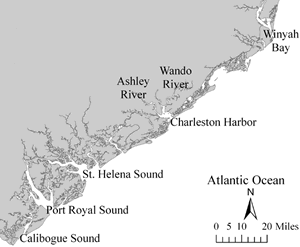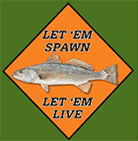Tracking Red Drum from Hatchery to Adulthood
Red drum are the most sought-after sportfish in South Carolina waters, providing significant ecological and economic benefits to the state. Their juvenile years, from age 0-5, are spent entirely within estuarine environments, after which they join adult offshore aggregations that spawn at the mouth of rivers and inlets in the late summer/early fall. Red drum have served as a model marine stock enhancement species in the United States and have been cultured and experimentally released in South Carolina since the late 1980s. When researchers at SCDNR began stocking red drum, they conducted experiments to determine the best season of release, size of fish at release, and use of appropriate marking methods. Stocked fish were routinely followed into the anglers’ creel and their contribution documented, with survival of stocked juveniles measured for up to four years post-stocking. A criterion for long-term success of red drum stock enhancement is that stocked fish attain sexual maturity and move into the offshore adult stock where it is expected that they will successfully reproduce.
SCDNR researchers use genetic tags as the primary method to identify stocked fish from wild fish because they are permanent marks and can be followed throughout the fishes’ life from larvae to adult. These genetic “tags” can be used like a fingerprint to identify a hatchery fish back to the tank in which it was originally spawned. Not only is it important to identify stocked fish one year after release, but it’s also extremely important to determine if stocked fish can be identified years later when they become adults. This is especially important if fishery managers intend to increase the size of the spawning population.
Some of the early stocking work we did in the Ashley River in 1999-2002 showed that stocking small 1-2 inch fish can make a big impact. In 1999, we stocked ~600,000 fish and found that ~36% of the red drum caught in the Charleston Harbor system the following year were stocked fish. In 2000, we stocked ~1 million small fish and 19% of red drum sampled the following year were found to be stocked fish (table 1).
Table 1. Red drum stocking and contribution in the Ashley River, 1999-2002.
| Year Stocked | Number Stocked | Contribution to Charleston Harbor (%) |
|---|---|---|
| 1999 | 617,190 | 35.9 |
| 2000 | 1,118,804 | 18.7 |
| 2001 | 1,066,366 | 14.0 |
We began sampling for red drum adults in September 2004, when the first five year-olds from the 1999 stocked year class would have joined the adult population. Adult fish were sampled using two longline methods aboard the R/V Silver Crescent from Winyah Bay down to Port Royal Sound (fig. 1). During the period from 2004-2012, over 1,200 adult red drum were sampled up and down the coast and released alive after a fin clip was taken for genetic analyses.

Figure 1. Locations of rivers where stocking occurred in Charleston Harbor and estuaries where longline sampling occurred along the South Carolina coast.
The overall contribution of stocked fish to the adult red drum population sampled along the South Carolina coast was 31 stocked red drum out of 1226 fish sampled, or just 2.5%.
What we discovered though, was that fish that spend their juvenile years in the Charleston Harbor system almost always return to the mouth of Charleston Harbor to spawn. So if we look at just adult red drum caught off Charleston, then the contribution of stocked fish was 5.7%. The other important thing to consider is that red drum have very long lives. They can live to be 40 years old! That means if it takes 5 years to be mature, then the big aggregations of spawning fish are made up of 6-40 year old fish and yet we still found that almost 6% were stocked fish.
If we were then to break up the age classes of fish and only look at the adult red drum that were likely to have been born in the years that stocking occurred, we would find that 31.5% of the red drum adults sampled from offshore Charleston were stocked fish. These numbers are similar to the 35% contribution that fish stocked in 1999 made to the Charleston Harbor system, suggesting that hatchery fish continue to make a contribution to the fishery as they transition into the adult population.
The highly localized effect of stocking indicated in our study suggests that fish stocked in Charleston Harbor will likely return to the mouth of Charleston Harbor to spawn when they join the adult population, a process known in fisheries science as “site fidelity.” Likewise, very few of the fish stocked in Charleston Harbor are likely to contribute to the adult aggregations that spawn in other South Carolina estuaries. Therefore, any future attempt to augment the adult red drum population statewide in South Carolina will require stocking to occur in several estuaries along the coast. This study provides the first evidence of recruitment of stocked red drum to the adult population and therefore suggests stocking small juveniles can be an effective management strategy for increasing adult population abundance.



